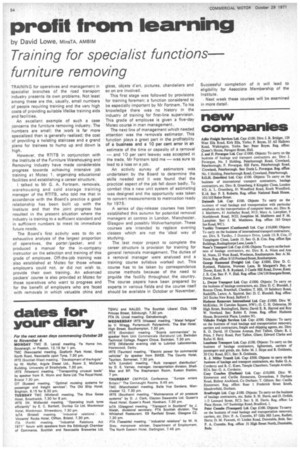profit from learning
Page 96

If you've noticed an error in this article please click here to report it so we can fix it.
by David Lowe, MInsTA, AMBIM
Training for specialist functions furniture removing
TRAINING for operatives and management in specialist branches of the road transport industry presents its own problems. Not least among these are the, usually, small numbers of people requiring training and the very high costs of providing suitable lifelike training aids and facilities.
An excellent example of such a case concerns the furniture removing industry. The numbers are small; the work is far more specialized than is generally realized; the cost of providing a twisting staircase and a grand piano for trainees to hump up and down is high.
However, the RTITB in conjunction with the Institute of the Furniture Warehousing and Removing Industry have made conaiderable progress towards achieving intensive job training at Mateo 1, organizing educational facilities and establishing a career structure.
I talked to Mr G. A. Fortnam, removals, warehousing and cold storage training manager of the RTITB , who told me that in accordance with the Board's practice a good relationship has been built up with the Institute and that the joint progress has resulted in the present situation where the industry is training to a sufficient standard and in sufficient numbers to meet its immediate future needs.
The Board's first activity was to do an exhaustive analysis of the largest proportion of operatives, the porter /packer, and it produced a manual for the in-company instructor on the selection and training of this grade of employee. Off-the-job training was also established at Motec for those whose employers could not, or did not wish to, provide their own training. An advanced packers' course is also provided at Mateo for those operatives who want to progress and for the benefit of employers who are faced with removals in which valuable china and glass, objets d'art, pictures, chandeliers and so on are involved.
This first stage was followed by provisions for training foremen; a function considered to be especially important by Mr Fortnam. To his knowledge there was no history in the industry of training for first-line supervision. This grade of employee is given a five-day Motec course in man management.
The next line of management which needed attention was the removals estimator. This function plays a great part in the profitability of a business and a 10 per cent error in an estimate of the time or capacity of a removal and 10 per cent leeway was accepted in the trade, Mr Fortnam told me was sure to lead to a loss on a job.
An activity survey of estimators was undertaken by the Board to determine the skills needed and it was found that the practical aspect of the job fell down badly. To combat this a new unit system of estimating was designed and the opportunity was taken to convert measurements to metrication ready for 1975.
A series of day-release courses has been established this autumn for potential removal managers at centres in London, Manchester, Glasgow and possibly Wolverhampton. These courses are intended to replace evening classes which are not the 'ideal way of studying.
The last major project to complete the career structure is provision for training for general removals management. The duties of a removal manager were analysed and a training course syllabus worked out. This course has to be taken by correspondence course methods because of the need to provide the facility throughout the country. The course papers have been prepared by experts in various fields and the course itself should be available in October or November.












































































































































